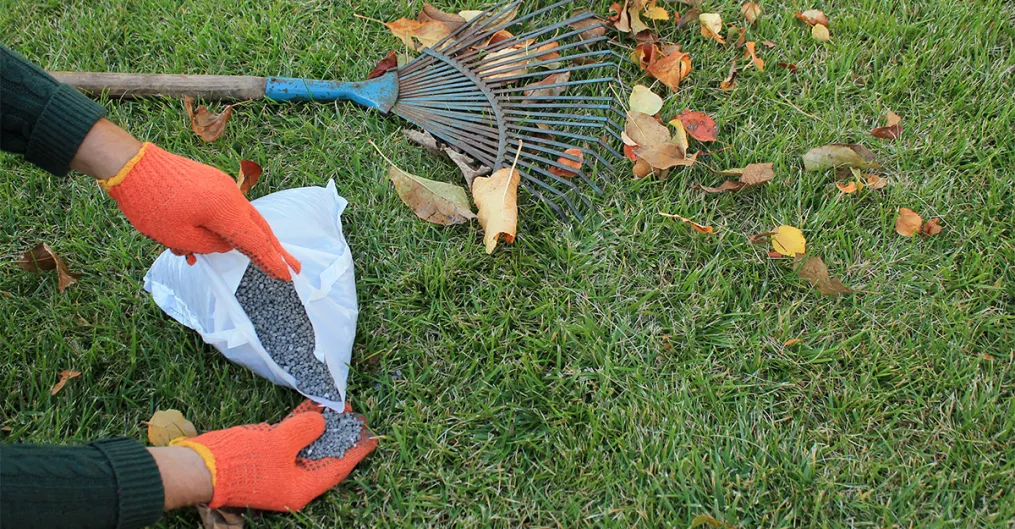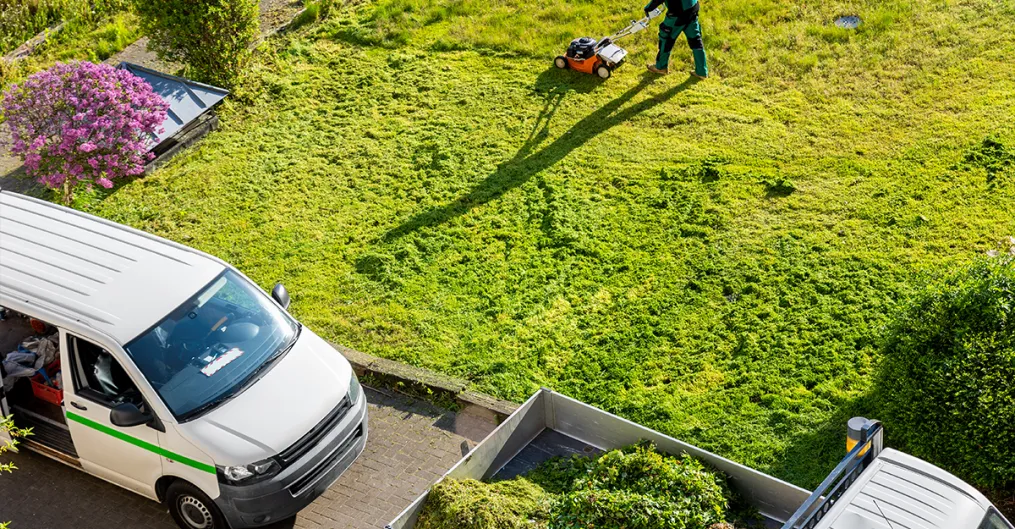As the days grow shorter and the nights arrive with a fresh chill, homeowners and gardening enthusiasts alike feel a sense of urgency—fall is here, and with it, the call to prepare our lawns for the impending winter. While autumn paints our trees with vivid colors and the mornings with dew, it also signals a critical period for lawn care. This job isn’t just a matter of aesthetics; it’s about setting a fall lawn care groundwork that will carry through the frost of winter and into the end of spring.
With the right knowledge and a touch of effort, you can ensure that your grass is not only surviving but thriving during winter time. From understanding the unique needs of your lawn in the fall to implementing the best practices for soil health, moisture management, and weed control—this guide is your companion through it all. Let’s walk through the steps to tuck in your turf and bid it good health until spring’s return. Now, roll up your sleeves, because your preparation starts with our fall lawn care guidelines.
The Autumn Audit: Assessing Your Lawn’s Health
The Visual Checkup
Initiate your lawn care regimen with a visual sweep. Inspect for any signs that denote stress, such as discoloration, bald spots, or an influx of weeds. This could signal issues like disease, poor nutrition, or improper pH levels. It’s also the moment to take note of any invasive plants or insects that might be making your lawn their home.
Testing the Terrain
If suspicions arise from your visual check, consider a soil test. This can reveal a lot about nutrient deficiencies and pH imbalances that might need correcting before winter sets in. Soil compaction is another common problem, detectable by its hard surface, which could necessitate aeration—a process we’ll touch on later.
Let’s Leave It to Nature: Dealing with Fall Foliage
The Battle Against Leaf Buildup
Leaves may look lovely on the trees, but once they blanket the ground, they can spell trouble for your lawn by blocking light and trapping moisture. This creates a haven for pests and diseases. The key here is consistency; don’t wait for all the leaves to fall before you start raking. Instead, make it a regular part of your lawn care routine.
Mulching as a Method
Alternatively, consider mulching your leaves. A mulching mower can chop leaves into fine pieces that decompose and nourish the lawn. However, this strategy is only effective if the leaf cover is not too thick; otherwise, the mulch can form a dense mat detrimental to grass growth.
Grass Class: Choosing the Right Seed
Selecting Seed
When overseeding your lawn, the choice of seed is paramount. Look for high-quality seed blends suited to your region’s climate and the existing grass type. Fall’s moderate temperatures and dewy mornings provide ideal conditions for seed germination, but timing is also crucial; aim to seed at least 45 days before your expected first frost.
Seeding Strategies
Spread the seed evenly and at the recommended rate. Following seeding, keep the soil consistently moist but not soggy to help new seedlings establish. And while it’s easy to get carried away with watering, remember that a light touch is often best.
Moisture Matters: Watering Wisely
Autumn’s Irrigation Adjustments
Although fall may bring more natural precipitation, monitoring and adjusting your watering schedule is essential. Typically, lawns need at least an inch of water per week, whether from rainfall or irrigation. Invest in a rain gauge to help you keep track, and remember to water early in the day to prevent disease and water waste.
Conserving Water
Overwatering can be just as harmful as drought, leading to shallow roots and fungal growth. As the season progresses and natural precipitation increases, limit your watering schedule. The goal is to encourage your lawn to develop deep roots that will find their own water deep in the soil, making for a hardier lawn that’s more resistant to the coldness of winter.
Nutrient Know-How: Fertilizing for Future Fertility

Understanding Fertilizers
Fall is the optimal time for fertilization because grass plants are absorbing and storing nutrients for the dormant winter period. A fertilizer with a higher ratio of potassium is ideal for fall; it enhances root growth, aids in disease resistance, and prepares grass for cold weather.
Controlled Application
When fertilizing, apply evenly and according to package directions. Over-fertilizing can lead to burn and excessive growth that won’t survive the winter. Moreover, remember to consider the environmental impact of runoff and use eco-friendly products where possible.
Compaction Correction: The Why and How of Aeration
How To Diagnose Compaction
Signs of soil compaction include a spongy feeling under one’s feet and difficulty penetrating the soil with a screwdriver. A lawn care solution to these symptoms will be to aerate the area.Aeration is a process that involves pulling small plugs of dirt out of the lawn to improve oxygen circulation and nutrient absorption.
Aerating Actions
For effective aeration, use a core aerator that extracts plugs of soil rather than simply poking holes. This method provides lasting benefits and should be done when the lawn is moist but not wet. Post-aeration, it’s a great time to overseed or fertilize as the treatments can reach deeper into the soil.
Lawn Care Warfare: Tackling Unwanted Guests
Preventive Measures
Weeds compete with grass for nutrients and space, so it’s ideal to address them as a part of one’s fall lawn care management. Pre-emergent herbicides can prevent weed seeds from germinating, thus reducing the number of weeds you’ll battle in the spring.
Spot Treatments
For those weeds that have already made their home in your lawn, post-emergent herbicides can be effective. It’s vital to apply them according to the instructions and in the right conditions—typically when it’s not too hot or windy—to prevent damage to other plants and minimize environmental impact.
Mowing Down: Adjusting Your Cutting Height
Raising the Bar
As fall progresses, raise the cutting height of your mower. Taller grass insulates the soil and provides more surface area for photosynthesis, which is crucial as the days shorten. Aim for about 2.5 to 3 inches in height, which can help prevent weed growth and protect against frost.
Last Cut Considerations
Before the start of winter, give your lawn a final mow at the raised height. Make sure your mower blades are sharp for a clean cut, as ragged edges can invite disease. This last trim is a precursor to the dormancy that will help the lawn conserve energy throughout the cold months.
Tool Time: Winterizing Your Lawn Care Equipment
Maintenance Matters
Cleaning and maintaining lawn care equipment ensures longevity and performance. Remove soil, grass clippings, and debris from all tools and machinery. Sharpen blades, oil moving parts, and for gas-powered equipment, either run the tank dry or add a fuel stabilizer.
Storage Solutions
Once serviced, store your tools in a dry, protected space. Properly winterizing your equipment will prevent rust, damage from freezing temperatures, and ensure everything is in working order when you need it again in the spring.
Wrapping Up and Reaching Out
With your lawn tucked in and tools tidied away, you’ve set the stage for a season of rest—for both the yard and the gardener. As the final leaves fall and the first frost glazes the grass, you can enjoy the peace of mind that comes from a job well done. If along the way, you find yourself in need of advice or assistance, or simply wish to share your own success stories, our door is always open.
Find A Suitable Lawn Care Partner

If you’re feeling the slightest uncertainty or simply wish for peace of mind, our team is here, ready to don our boots and join you in the final strides of lawn care and preparation. We bring not just our rakes and fertilizers, but a passion for verdant lawns and the shared joy of spring’s first bloom. Let’s collaborate to wrap your lawn in the warmth of expert care, setting the stage for a dazzling green reawakening.
Whether you seek a comprehensive assessment, a tailored winterization plan, or just an extra pair of hands to perfect your preparations, reach out to us. We’re poised to answer your call, share in your lawn’s journey, and celebrate the fruits of our joint efforts after the winter season. Contact us today—because the most vibrant lawns are the result of foresight, care, and the touch of dedicated hands. Your lawn is a testament to your commitment; let us be the allies in your garden’s story.

